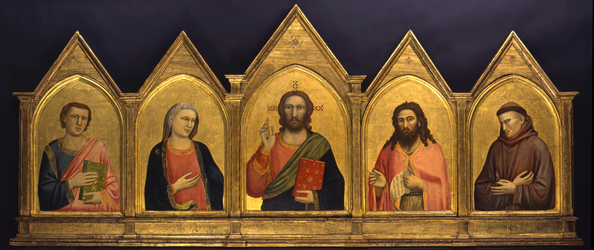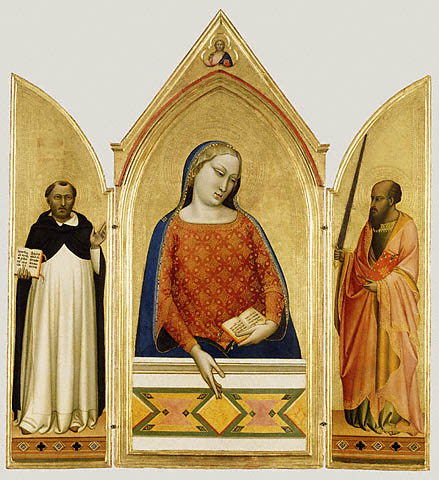Thursday, June 28, 2012
Revealing the Renaissance: Art in Early Florence
The splendour and devotion of the Early Renaissance come to life at the Art Gallery of Ontario (AGO) next spring with a large-scale exhibition of Florentine masterpieces, presented in partnership with the world renowned J. Paul Getty Museum in Los Angeles.
Revealing the Renaissance: Art in Early Florence brings together rare panel paintings, manuscripts, sculpture and stained glass to tell the inside story of how the artists of one city brought about the birth of the Renaissance. Thanks to new scientific and art-historical research into the materials and techniques employed by painters of the time, as well as interactive iPad stations, audiences will learn more about how these masterpieces were created. The exhibition will take place at the AGO from March 16 to June 16, 2013.
Revealing the Renaissance: Art in Early Florenceis presented in collaboration with the J. Paul Getty Museum of Los Angeles, which will display the exhibition from Nov. 13, 2012 to Feb. 10, 2013 under the title Florence at the Dawn of the Renaissance: Painting and Illumination, 1300–1350.
The exhibition comprises more than 90 key pieces from the first half of the 14th century, including Giotto’s five-panel Peruzzi Altarpiece and his Madonna of San Giorgio alla Costa, two painted and hand-written copies of Dante’s Divine Comedy, and Bernardo Daddi’s Virgin Mary with Saints Thomas Aquinas and Paul. The works, which have been secured by a team of staff members from the AGO and the Getty, will transport audiences back in time to Florence in the Early Renaissance.
“The AGO is proud to join forces with the Getty Museum, which is renowned internationally for its exhibitions, conservation and research,” said Matthew Teitelbaum, director and CEO of the AGO. “This exhibition and the programming around it allow us to look at one of the most crucial periods in Western art history with fresh eyes. We invite visitors to view these seminal works through a contemporary lens, relating the issues of Florentine society at the dawn of the Renaissance to those of our modern lives.”
Subdivided into various themes,Revealing the Renaissance: Art in Early Florence will explore how the city’s burgeoning economy of the time fostered a unique demand for artworks both religious and civic, as well as the collaborative nature of artistic production, a closer look at the workshops of artists, the stories behind the works and their subjects and insight into conservation research. Visitors will interact with the exhibition at numerous hands-on stations, offering the opportunity to explore inside the Renaissance artist’s studio, discover the pigments and tools used, hear music from a book whose pages will be reunited for the first time in over a century, view footage of Florence and see aspects of the works through the microscopes of conservators.
Curated by Christine Sciacca, assistant curator of manuscripts at the J. Paul Getty Museum, together with coordinating curator Sasha Suda, assistant curator of European art at the AGO, Revealing the Renaissance: Art in Early Florence will bring to life recent discoveries about artistic techniques and studio practice in Florence between 1300 and 1350. In conjunction with the exhibition, the AGO will host a public symposium that will assemble leading international experts to discuss the relationship between scientific research and art history.
"The exhibition features artists who were masters in both panel painting and manuscript illumination in the vibrant cultural climate of 14th-century Florence," explained Sciacca. "With new findings about artistic techniques and artists' workshops based on conservation research and scientific analysis, we are able to present a rich, nuanced picture of the beauty and creativity of artistic production in Florence." According to Suda, “this exhibition will make it clear that the diverse artistic practices of Giotto and his contemporaries paved the way for generations of Italian Renaissance masters to come.”
The exhibition is the first of its kind in Canada, as many of the treasured works have never travelled before and likely will not again for generations to come. Notable works include:
• Giotto di Bondone, Pentecost, Tempera and gold leaf on panel, 43 cm x 31.7 cm (The National Gallery, London)
• Giotto di Bondone, Madonna of San Giorgio alla Costa, Tempera and gold leaf on panel, 180 cm x 90 cm (Museo Diocesano di Santo Stefano al Ponte, Florence)
• Bernardo Daddi, The Virgin Mary with Saints Thomas Aquinas and Paul, Tempera and gold leaf on panel, 120.7 cm x 55.9 cm (Getty)
• Pacino di Bonaguida, Polyptych: The Crucifixion, Saint Nicholas, Saint Bartholomew, Saint Florentius, and Saint Luke, 182 cm x 249 cm (Galleria dell’Accademia, Florence)
• Pacino di Bonaguida, Carmina regia: The Appeal of Prato to Robert of Anjou, 47.7 cm x 34.2 cm (The British Library, London)
• Biadaiolo Illuminator, Specchio Umano, 38.5 cm x 27.2 cm (Biblioteca Medicea Laurenziana, Florence)
PUBLICATION:
A catalogue, Florence at the Dawn of the Renaissance: Painting and Illumination, 1300-1350 will be published to accompany the exhibition.




